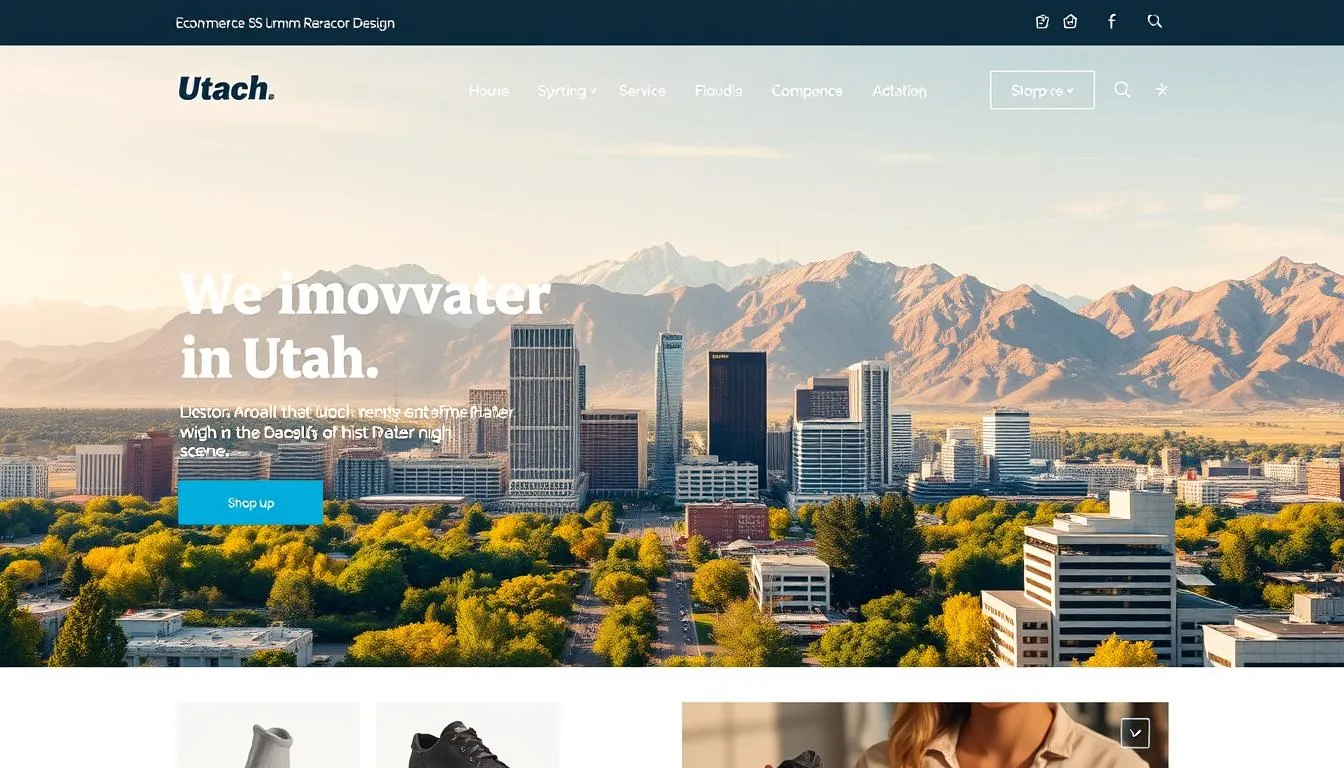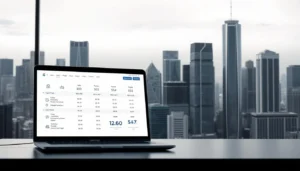Last Updated on: June 19, 2025
In today’s digital landscape, having a robust online presence is crucial for businesses in Utah. A well-crafted ecommerce website design can be the key to unlocking your business’s full potential, enabling you to reach a wider audience and drive sales.
A professional ecommerce website not only enhances user experience but also builds trust with your customers. By investing in ecommerce solutions Utah, businesses can stay ahead of the competition and achieve their goals.
With the right ecommerce web design, Utah businesses can improve their online visibility, increase conversions, and ultimately boost revenue.
Key Takeaways
- Professional ecommerce website design enhances user experience.
- Ecommerce solutions Utah help businesses stay competitive.
- A well-designed ecommerce site can increase conversions and revenue.
- Investing in ecommerce web design utah can improve online visibility.
- Businesses in Utah can achieve their goals with the right ecommerce solutions.
The Growing Importance of Ecommerce for Utah Businesses
In Utah, the shift towards ecommerce is gaining momentum, driven by both local market conditions and global ecommerce trends. As consumers increasingly turn to online shopping, businesses in Utah are recognizing the importance of having a robust ecommerce presence.
Current Ecommerce Trends in Utah’s Market
Utah’s ecommerce market is characterized by a growing demand for online shopping, with consumers seeking a seamless and personalized experience. Mobile commerce is on the rise, with many consumers using their smartphones to browse and purchase products online. Businesses must adapt to these trends by optimizing their websites for mobile devices and providing a user-friendly experience.
How the Pandemic Reshaped Digital Business Landscape
The COVID-19 pandemic has had a profound impact on the digital business landscape in Utah, accelerating the adoption of ecommerce as consumers turned to online shopping due to social distancing measures. This shift has forced businesses to rethink their ecommerce strategies, focusing on digital transformation and online engagement. As a result, many Utah businesses have seen significant growth in their online sales channels.
The pandemic has also highlighted the importance of having a flexible and scalable ecommerce platform that can adapt to changing consumer behaviors and market conditions.
Why Professional Ecommerce Web Design Matters
Professional ecommerce web design plays a vital role in establishing a strong online presence and fostering customer trust. In today’s digital landscape, a well-designed ecommerce website is crucial for businesses aiming to attract and retain customers. A professional design not only enhances the visual appeal of the site but also improves its functionality and user experience.
The significance of ecommerce web design can be seen in several key areas. Firstly, it directly impacts brand perception online. A well-designed website conveys a sense of professionalism and reliability, making customers more likely to trust the brand. Conversely, a poorly designed site can deter potential customers and harm the brand’s reputation.
First Impressions and Brand Perception Online
The first impression a customer has of an ecommerce site is often formed within seconds of landing on the homepage. This initial impression can significantly influence their decision to stay, explore, or leave the site. A professional ecommerce web design ensures that the first impression is positive, engaging, and reflective of the brand’s values.
Key elements that contribute to a positive first impression include:
- A clean and intuitive layout
- High-quality product images and descriptions
- Clear calls-to-action (CTAs)
- Responsive design for various devices
By incorporating these elements, businesses can create a strong brand perception online, encouraging customers to explore the site further and ultimately make a purchase.
Conversion Rate Optimization Fundamentals for Utah Businesses
Conversion Rate Optimization (CRO) is a critical aspect of ecommerce web design that focuses on increasing the percentage of website visitors who complete a desired action, such as making a purchase. For Utah businesses, understanding CRO fundamentals is essential for maximizing the return on investment from their ecommerce site.
By implementing these CRO strategies, Utah businesses can enhance their ecommerce web design, leading to improved conversion rates and ultimately, increased revenue.
Essential Elements of Effective Ecommerce Web Design Utah
Effective ecommerce web design in Utah involves more than just aesthetics; it’s about creating a seamless user experience that drives conversions and fosters customer loyalty. A well-designed ecommerce site is crucial for businesses looking to establish a strong online presence.
User Experience (UX) Best Practices for Online Stores
Implementing ecommerce UX best practices is vital for creating an intuitive and engaging online shopping experience. This includes simplifying navigation, using clear product categorization, and ensuring that product information is easily accessible. Streamlining the checkout process is also crucial to reduce cart abandonment rates.
Mobile Responsiveness Requirements for Today’s Consumers
With the majority of online shoppers using mobile devices, mobile responsiveness is no longer optional. A mobile-responsive design ensures that your ecommerce site adapts seamlessly to different screen sizes, providing an optimal viewing experience for all users. This not only improves user experience but also positively impacts search engine rankings.
Security Features That Build Customer Trust
Security is a top concern for online shoppers. Implementing robust security features for ecommerce sites, such as SSL certificates and trust badges, helps build customer trust. Clearly displaying security measures can significantly reduce cart abandonment rates and increase customer confidence in your brand.
By incorporating these essential elements, Utah businesses can create effective ecommerce web designs that attract and retain customers, driving long-term success.
Utah Market Considerations for Your Ecommerce Store
To succeed in Utah’s competitive ecommerce market, businesses must understand local consumer behavior and preferences. The Beehive State’s unique blend of urban and rural populations, along with its strong economy, creates a distinct ecommerce landscape.
Local Consumer Behavior Insights and Preferences
Utah consumers tend to be tech-savvy and active online shoppers. Research indicates that:
- Utahns have a high internet penetration rate, making online shopping a preferred method for many.
- Mobile commerce is on the rise, with a significant portion of online sales coming from mobile devices.
- Local consumers value fast shipping and reliable customer service.
Understanding these preferences can help ecommerce businesses tailor their strategies to meet the needs of Utah consumers.
Competitive Landscape Analysis in the Utah Market
The Utah ecommerce market is competitive, with both local and national players vying for market share. Key aspects to consider include:
- Identifying niche markets or product categories with less competition.
- Analyzing competitors’ strengths and weaknesses to differentiate your business.
- Leveraging local SEO strategies to improve visibility in search results.
By understanding the competitive landscape and local consumer behavior, ecommerce businesses can develop effective strategies to succeed in the Utah market.
Ecommerce Platform Options for Utah Businesses
The choice of ecommerce platform can significantly impact the success of Utah businesses in the competitive online market. With various options available, each catering to different business needs and sizes, selecting the right platform is crucial.
Shopify Solutions and Benefits
Shopify is a popular choice for Utah businesses due to its user-friendly interface, scalability, and extensive app ecosystem. It offers a range of customizable themes and integrates with various payment gateways, making it suitable for businesses of all sizes.
WooCommerce Integration Possibilities
WooCommerce is a flexible ecommerce solution for businesses already using WordPress. It offers extensive customization options and integrates seamlessly with WordPress themes and plugins, making it ideal for businesses looking for a highly customizable ecommerce platform.
Magento Development for Larger Enterprises
Magento is a robust ecommerce platform designed for larger enterprises. It offers advanced features such as multi-store management, extensive product catalog management, and robust security features, making it suitable for complex ecommerce operations.
Custom Platform Considerations and Use Cases
Custom ecommerce platforms offer tailored solutions for unique business requirements. While they require significant investment, custom platforms can provide a competitive edge through unique features and integrations not available on other platforms.
The Process of Creating Your Ecommerce Website
To establish a strong online presence, understanding the ecommerce website creation process is crucial. This process involves several key stages that work together to ensure your online store is both visually appealing and functional.
Discovery and Planning Phase: Setting Goals and Expectations
The discovery phase is where your ecommerce project begins. During this stage, we’ll work together to define your business goals, identify your target audience, and outline the key features your website needs. This phase is crucial for setting clear expectations and creating a roadmap for your project’s success.
Design and Development Timeline: What to Expect
Once the planning phase is complete, we move into the design and development stage. This is where your ecommerce website starts to take shape. The timeline for this phase can vary depending on the complexity of your project, but typically, you can expect it to take several weeks to a few months. We’ll work closely with you to ensure that the design aligns with your brand and that the development meets your functional requirements.
Testing, Launch, and Post-Launch Support
Before your ecommerce website goes live, we’ll conduct thorough testing to ensure everything works as expected. This includes checking for bugs, verifying payment processing, and testing user experience. After launching your site, we’ll provide ongoing support to address any issues that may arise and help you keep your site updated and secure. As one ecommerce expert noted,
“A well-designed ecommerce site is not just about aesthetics; it’s about creating a seamless user experience that drives conversions.”
By understanding these stages, you can better prepare for the ecommerce website creation process and set your business up for online success.
SEO Strategies for Utah Ecommerce Businesses
To thrive in Utah’s ecommerce scene, businesses must prioritize SEO strategies that enhance their online presence. Effective SEO is crucial for driving visibility, sales, and growth in the competitive digital marketplace.
Local SEO Tactics to Reach Utah Customers
Local SEO tactics are essential for Utah ecommerce businesses to reach their target audience. This includes optimizing the website for location-based keywords, creating content relevant to local customers, and ensuring the business is listed in local directories and Google My Business.
Product Page Optimization for Better Conversions
Optimizing product pages is critical for better conversions. This involves using high-quality product images, writing detailed and keyword-rich product descriptions, and ensuring that product pages load quickly to improve user experience.
Content Marketing Strategies for Ecommerce Growth
Content marketing is a powerful strategy for ecommerce growth. By creating valuable and relevant content, businesses can attract and retain customers, drive sales, and build brand loyalty. This can include blog posts, videos, and social media content that addresses customer needs and interests.
By implementing these SEO strategies, Utah ecommerce businesses can improve their online visibility, drive more sales, and achieve sustainable growth in the competitive ecommerce landscape.
Integration Capabilities for Your Business Systems
Effective ecommerce integration capabilities are crucial for streamlining business operations and enhancing overall efficiency. By integrating various business systems, ecommerce businesses in Utah can automate processes, reduce manual errors, and improve customer satisfaction. This integration enables businesses to operate more cohesively, making data-driven decisions easier.
Inventory Management and ERP Integration
Inventory management and ERP (Enterprise Resource Planning) integration are vital for ecommerce businesses to manage their stock levels, orders, and supply chain efficiently. This integration allows for real-time updates on inventory levels, automates order fulfillment, and streamlines financial reporting. By integrating inventory management and ERP systems with their ecommerce platform, businesses can avoid stockouts, overstocking, and improve their overall operational efficiency.
CRM and Marketing Automation Connections
Integrating CRM (Customer Relationship Management) and marketing automation systems with ecommerce platforms enables businesses to personalize customer interactions, enhance customer engagement, and drive sales. By connecting these systems, businesses can access comprehensive customer data, automate marketing campaigns, and analyze customer behavior to improve their marketing strategies.
- Personalized customer experiences through integrated CRM data
- Automated marketing campaigns based on customer behavior and preferences
- Enhanced customer engagement through targeted marketing efforts
Success Stories: Utah Businesses Thriving Online
The state of Utah has become a hotbed for ecommerce success stories, with businesses across various sectors flourishing online. This success is not limited to a single industry, as both retail and service-based businesses have seen significant growth.
Case Study: Retail Business Transformation
A notable example of retail business transformation is the story of Utah-based outdoor gear retailer, which shifted its focus to ecommerce during the pandemic. By implementing a robust ecommerce platform and optimizing their website for user experience, they saw a 50% increase in online sales within six months.
Case Study: Service-Based Business Growth
Service-based businesses have also thrived online, with companies like Utah Health Services experiencing significant growth. By leveraging ecommerce for appointment scheduling and service sales, they achieved a 30% increase in service bookings through their online channel.
Lessons Learned from Successful Utah Ecommerce Sites
Successful Utah ecommerce sites share common traits, including a focus on user experience, mobile responsiveness, and effective SEO strategies. A comparative analysis of these sites reveals key factors contributing to their success.
By understanding these success stories and the factors that contribute to them, Utah businesses can better navigate the ecommerce landscape and achieve their own online success.
Investment Considerations and ROI Expectations
For Utah businesses, understanding the investment considerations and ROI expectations of ecommerce development is essential. As the digital landscape continues to evolve, companies must be prepared to make informed decisions about their online presence.
“The key to a successful ecommerce investment is not just about the initial cost, but also about understanding the potential return on investment,” says industry experts. This involves considering various factors, including the pricing models for ecommerce development and how to measure the effectiveness of an ecommerce site.
Typical Pricing Models for Ecommerce Development in Utah
Ecommerce development pricing in Utah can vary based on several factors, including the complexity of the site, the technology used, and the agency or developer chosen. Typical pricing models include:
- Fixed-price projects
- Hourly rate-based projects
- Monthly retainer models
Each model has its advantages and is suited to different business needs and budgets.
Measuring Return on Investment from Your Ecommerce Site
To measure the ROI of an ecommerce site, businesses should track key performance indicators (KPIs) such as conversion rates, average order value, and customer acquisition costs. By analyzing these metrics, businesses can gain insights into their ecommerce site’s effectiveness and make data-driven decisions to improve performance.
Key metrics to track include:
- Conversion rates
- Average order value
- Customer lifetime value
By focusing on these metrics, Utah businesses can optimize their ecommerce sites for better ROI.
Choosing the Right Ecommerce Web Design Partner in Utah
Selecting the right ecommerce web design partner is crucial for Utah businesses looking to establish a strong online presence. A competent partner can help create a website that not only looks great but also drives sales and growth.
Essential Questions to Ask Potential Design Partners
When searching for an ecommerce web design partner, it’s essential to ask the right questions. These include inquiries about their experience with ecommerce projects, their design process, and how they handle mobile responsiveness and security features. You should also ask about their approach to SEO strategies and how they can help improve your website’s visibility.
- What ecommerce platforms do you specialize in?
- Can you share examples of previous ecommerce projects?
- How do you approach user experience (UX) design?
Red Flags to Watch For When Selecting a Provider
While evaluating potential ecommerce web design partners, be aware of red flags such as a lack of transparency in their pricing or process, poor communication, and a portfolio that lacks ecommerce examples. Beware of partners who promise unrealistic results or use cookie-cutter solutions that may not be tailored to your business needs.
Conclusion: Taking the Next Step in Your Ecommerce Journey
As we’ve explored throughout this article, a well-designed ecommerce website is crucial for Utah businesses looking to thrive in today’s digital landscape. By understanding the importance of ecommerce, selecting the right platform, and implementing effective SEO strategies, you can unlock your business’s full potential.
Now that you’ve gained insights into ecommerce web design in Utah, it’s time to take the next step in your ecommerce journey. Whether you’re just starting out or looking to revamp your existing online store, the key is to stay focused on your customers’ needs and preferences.
By doing so, you’ll be well on your way to creating a seamless online shopping experience that drives conversions and fosters long-term growth. Take the first step today by assessing your current ecommerce presence and identifying areas for improvement. With the right strategy and expertise, you can successfully navigate the next steps in ecommerce and achieve your business goals.
FAQ
What is ecommerce web design, and why is it important for Utah businesses?
Ecommerce web design refers to the process of creating an online store that is visually appealing, user-friendly, and optimized for conversions. It is crucial for Utah businesses as it enables them to establish a strong online presence, reach a wider audience, and drive sales.
How has the pandemic impacted the ecommerce landscape in Utah?
The pandemic has accelerated the growth of ecommerce in Utah, with more consumers turning to online shopping due to social distancing measures and lockdowns. As a result, Utah businesses have had to adapt their ecommerce strategies to meet the changing needs of their customers.
What are the key elements of effective ecommerce web design?
Effective ecommerce web design includes user experience (UX) best practices, mobile responsiveness, security features, and conversion rate optimization. These elements work together to create an online store that is both visually appealing and functional.
How do I choose the right ecommerce platform for my Utah business?
When selecting an ecommerce platform, consider factors such as scalability, customization options, integrations with third-party tools, and payment gateways. Popular ecommerce platforms for Utah businesses include Shopify, WooCommerce, and Magento.
What is the typical cost of ecommerce web design in Utah?
The cost of ecommerce web design in Utah varies depending on factors such as the complexity of the design, the number of pages, and the technology used. Typical pricing models include fixed-price, hourly, and retainer-based models.
How can I measure the return on investment (ROI) of my ecommerce site?
To measure the ROI of your ecommerce site, track key performance indicators (KPIs) such as conversion rates, average order value, and customer acquisition costs. Analyze these metrics to determine the effectiveness of your ecommerce strategy and identify areas for improvement.
What are some common mistakes to avoid when designing an ecommerce website?
Common mistakes to avoid include poor navigation, lack of mobile responsiveness, inadequate security measures, and slow page loading speeds. By avoiding these mistakes, you can create an ecommerce website that provides a positive user experience and drives conversions.
How can I optimize my ecommerce site for search engines?
To optimize your ecommerce site for search engines, focus on strategies such as keyword research, on-page optimization, product page optimization, and content marketing. These tactics can help improve your site’s visibility, drive organic traffic, and increase conversions.




